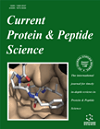-
oa Editorial [Hot Topic: Peptides, Metabolic Dysregulation, Aging (Guest Editor: Miklos Szekely)]
- Source: Current Protein and Peptide Science, Volume 12, Issue 4, Jun 2011, p. 269 - 270
-
- 01 Jun 2011
Abstract
Energy balance of mammals is a complex system that involves a great variety of factors: ingestion of calorie containing substances has to be counterbalanced by various components of the overall metabolic rate and energy expenditure (e.g., heat loss). When this balance is well established, it means an optimal development and later stable maintenance of body weight, well-regulated body temperature [1, 2] and it is also connected with nutrient utilization (intermediary metabolism). However, individual components of this balance (regulation of food intake, body weight, body temperature, etc.) are determined by a plethora of factors including age and/or body composition [2-4]. The overall energy balance must be positive and must lead to weight gain in juvenile age-groups until reaching young adulthood. However, in the course of further development and aging it often remains positive leading to obesity, particularly in middle-aged mammals (both humans and animals). In very old populations on the other hand, a negative balance is reflected by the aging anorexia and cachexia. These age-related changes are accompanied by alterations in body composition and in intermediary metabolism: middle-aged obesity in most cases refers to visceral fat accumulation, with adjoining decrease in insulin sensitivity or manifest diabetes [5], while aging anorexia and cachexia means a dramatic fall in active tissues, especially that of skeletal muscles leading to sarcopenia and fragility in old age-groups [6]. Great complexity characterizes the regulatory mechanisms that determine energy balance at any age. Peripheral neural and humoral signals not only contribute to the short-term modifications of the system (hunger/satiety, thermal balance, nutrient utilization), but they also affect the long-term regulations including regulation of body weight, body composition, or peripheral insulin sensitivity [2, 7]. The great variety of peripheral signals may act through activation/inhibition of the basic central components of regulation or at least in conjunction with their activities. In this respect, the hypothalamic and brainstem nuclei are the central structures of utmost importance [8]. Among the multitude of signals that finally determine the function of central regulatory systems, various peptides play an extraordinary role. Some of these peptides originate from peripheral tissues and influence brainstem and hypothalamic regulatory processes of energy balance, others are produced in neurons of the central nervous system (neuropeptides) as important participants in these regulations, and they can also influence processes of peripheral tissue metabolism. Leptin, a peptide hormone of the adipose tissue as well as insulin of peripheral origin acts centrally (mainly in the hypothalamic arcuate nucleus) and, via downstream pathways, both peptides have catabolic actions (e.g., they enhance the activity of the melanocortin system and inhibit that of neuropeptide Y) [9]. Via the vagus and the brainstem, brain-gut peptide cholecystokinin (CCK) also exhibits catabolic effects [10, 11]. Plasma level of a number of these peptides increases, while their anorexigenic and overall catabolic efficacy decreases with age [12], although food restriction at least partially prevents this decrease [5, 12]. In contrast, ghrelin originating from the stomach is orexigenic, but its efficacy has also been shown to decline with age [13]. Some other hypothalamic neuropeptides (e.g. orexin) have been demonstrated to lose from their orexigenic [13] activities in the course of aging, although enhanced expression of anorexigenic peptides (e.g. cocaine-amphetamine regulated transcript) has also been reported [14]. The short reviews in the present issue of Current Protein and Peptide Science are either related to the role of various peptides in (or to peptide effects on) the regulation of factors of energy balance in function of age, or they are related to the ageassociated insulin resistance. Peripheral ghrelin and CCK actions have been analyzed by Stengel and Tache, one peptide being orexigenic, the other one anorexigenic. One of the important findings is that the amount of orexigenic ghrelin, which is produced by the X/A cells of the stomach and acts via the vagus and the nucleus of the solitary tract, depends on the action of ghrelin-O-acyltransferase. Changes in the activity of this enzyme can alter the ratio of the active ghrelin and its non-orexigenic form desacyl-ghrelin and thereby the enzyme may influence the overall orexigenic activity. Regarding CCK actions, nesfatin (originating from the same gastric cells partly in response to peripheral CCK) is anorexigenic. Simultaneously, CCK also suppresses ghrelin level. The peptide itself may also act as an anorexigenic mediator (via CCK2 receptors) on central structures. The orexigenic and antidipsogenic actions of ghrelin constitute the topic of another paper by Hashimoto and Ueta. This analysis may be of importance, since in some studies of food intake liquid food is applied [15] and the antidipsogenic effects of ghrelin may be relevant in the evaluation of the results of such experiments. An extensive review of Kmiec deals with thorough analysis of the role of peripheral and central peptides in age-related changes of food intake. This work describes that in rodents both the expression and activity of orexigenic and anorexigenic peptides may change with aging. Another review from Petervari et al. (also on basis of experiments on rodents) summarizes the continuously changing role of these peptides in the overall regulation of energy balance during the course of aging, and possibly offers an explanation for the high prevalence of obesity in middle-aged animals and for that of aging anorexia in the old ones. Age-related development of leptin and insulin resistance with and without visceral adiposity, with and without calorie restriction is analyzed in another remarkable review by Carrascosa et al. In this paper data for the possible role of inflammatory cytokines in cases of increased adiposity are also collected - apparently, these cytokines may influence metabolism of peripheral tissues. Although the authors could not reach a decisive conclusion on the role of age vs. adiposity in these processes, they presented and very thoroughly discussed the available data regarding this problem.....


